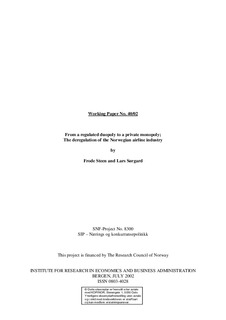| dc.description.abstract | We explain the economics of deregulation in the Norwegian market. We observed a transition from a regulated duopoly prior to 1994 to a monopolised airline market in 2001. We explain how eight years of deregulation and competition led to this outcome. In particular we discuss and model a feature of the Norwegian airline market that was one of the main factors behind the merger; the competition on the large customer contracts. We explain how these contracts led to Bertrand-like competition on the large customers and a prisoner’s dilemma situation for the airline companies. They operated costly excess capacity, they did not price discriminate correctly according to the demand elasticities, and they lost a lot of revenue from fierce competition for the large customers. The merger solved all these problems. Then within the present competitive situation, which resembles the situation in most European countries with one large dominating flag-carrier, we discuss some measures we believe may create future domestic competition. We focus on the anticompetitive effect of frequent flyer programs, but also discuss issues like airport charges, airport handling and predatory behaviour. Finally, we briefly comment upon the future situation and the European low-cost-no-frills ‘revolution’. | en |
